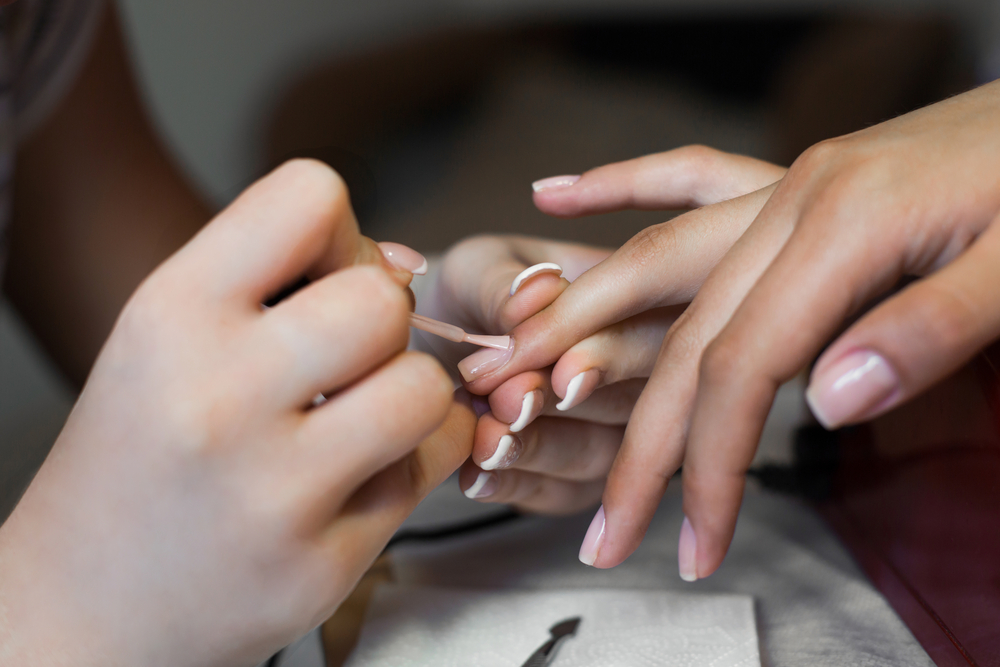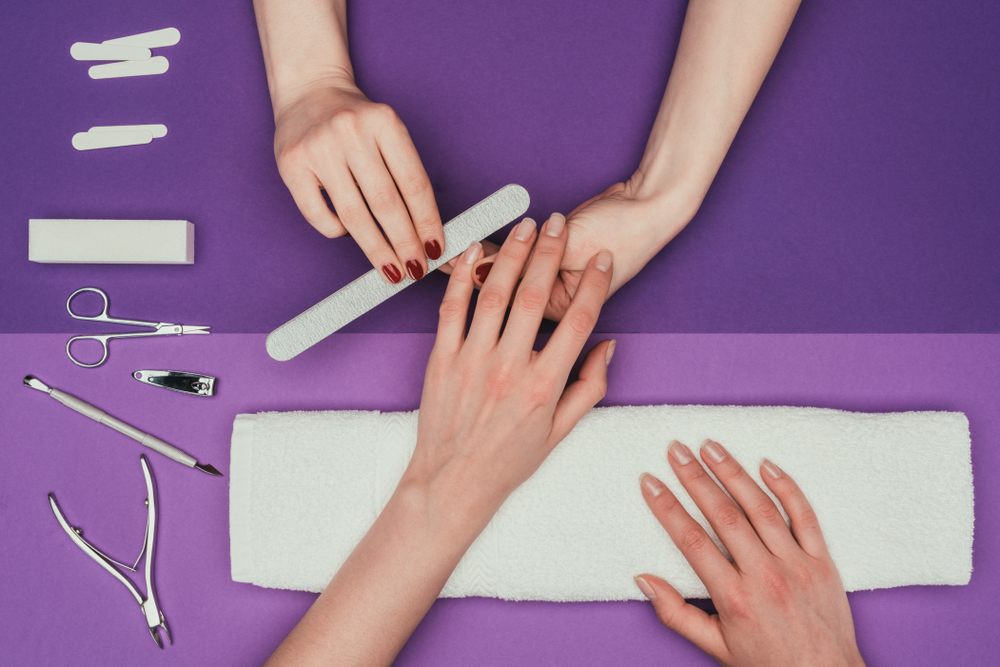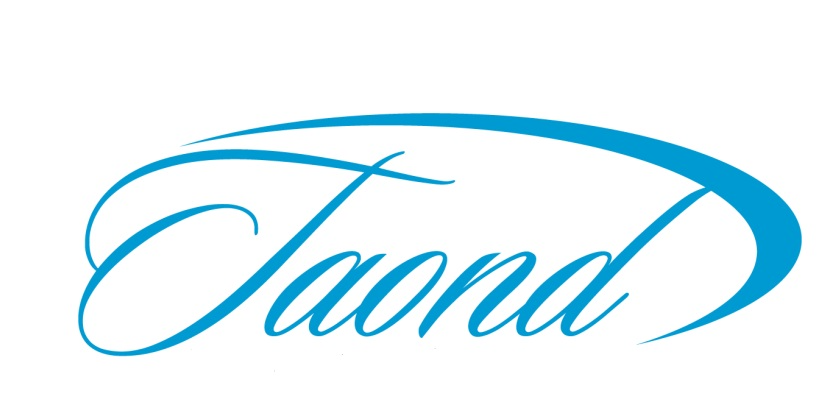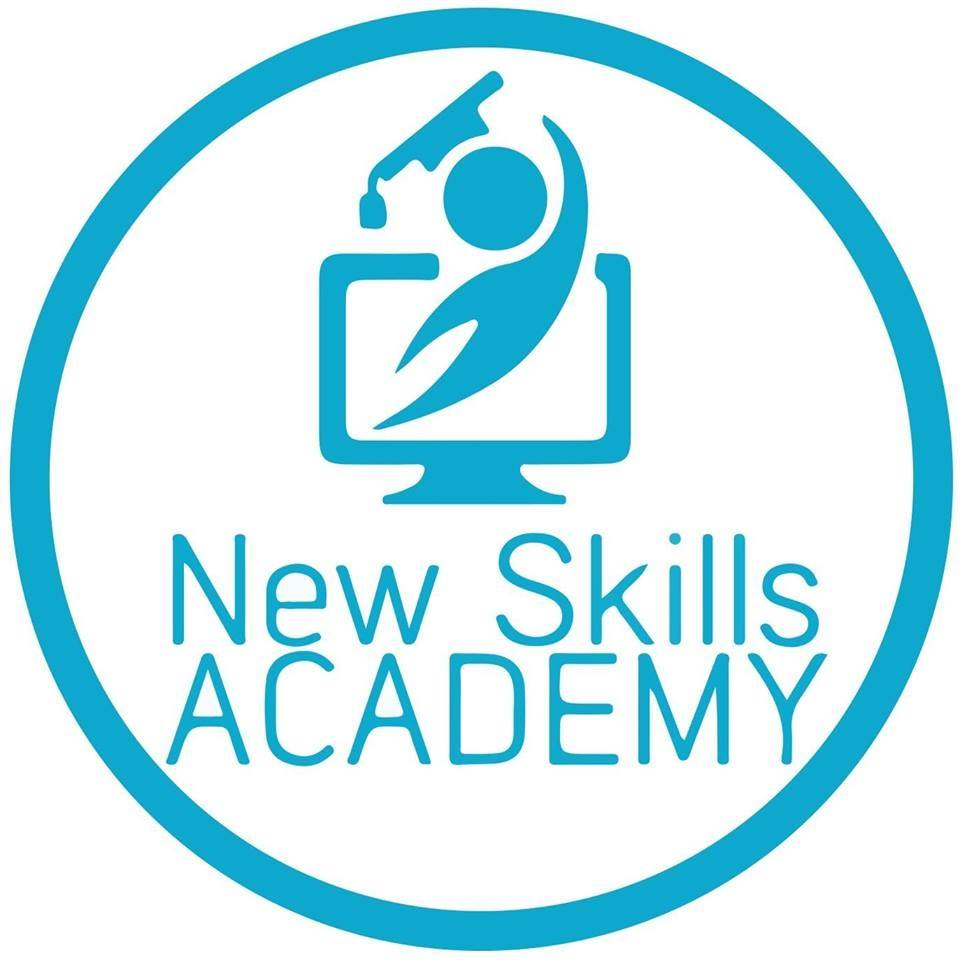- Choosing an Online Nail Technician Course
- Course Comparison at a Glance
- Top 6 Best Nail Technician Courses 2024
- 1. Udemy: Expert Nail Technician Course
- 2. Skillshare: Nail Art – Colorful, Creative Designs to Paint and Share
- 3. The Academy of Nail Design: Full Certificate Program
- 4. Udemy: Your Guide to Becoming the Best Nail Tech
- 5. New Skills Academy: Nail Artistry Certification
- 6. Skillshare: Nail Art Course With Painting Gel
- Best Online Nail Technician Courses 2024: Top 5 Frequently Asked Questions
- Extra Credit
- Time to Make Your Statement
Nail art and nail painting can be a therapeutic form of art and expression for creative individuals. While the act of nail painting may seem quite easy at first glance, there is a lot of technique, skill, and patience that goes into creating beautiful-looking nails, particularly when working with different nail products.
While nail painting does require a lot of skill and patience, there EW many ways you can improve your nail art abilities and get better at creating well-manicured nails. Whether nail art and design are something you’re considering as a career choice, or you simply want to save on salon fees and do your own nails, an online course is a great place to gain a better understanding of nail design.
While you don’t need any formal training to do your own nails at home, an online nail technician training course will equip you with the basic techniques you’ll need to perform high-quality manicures in an at-home or professional setting. If you’re looking to gain employment in the beauty industry as a nail technician, completing an online training course will not only add credibility to your name, but will make it much easier to gain a license when the time comes to start working.
Choosing an Online Nail Technician Course
If you have no prior experience or training as a nail technician, it will be almost impossible to jump straight into using different nail styling techniques. Before you begin, you’ll need to consider your current goals, why you want to learn more about being a nail technician, your existing knowledge and experience level, and which nail styling techniques you’re most interested in.
Taking an online nail technician training course is the most efficient and practical way to gain a better understanding of what it takes to become a nail technician. However, not all online nail technician courses will provide you with the same level of understanding and technique. When you’re considering an online nail technician training course, you need to make sure your chosen course aligns with your personal or professional goals.
Therefore, before choosing an online nail technician training course, you should consider the following factors.
Knowledge Level
Before you decide on an online nail technician course, take a moment to establish your current skill and knowledge level when it comes to nail art and nail painting techniques.
If you’re starting from complete scratch and have little to no experience working with nails, the course best suited to you will contain a more comprehensive introduction to being a nail technician and a complete breakdown of the various tools, equipment, and techniques that you’ll be using.
If you’re already quite nifty with nail art at home and you’re looking to take your passion to the next level, a more tailored course might better suit your needs. Look for a course that addresses a specific area of interest, such as acrylic nails or gel nails, to ensure you don’t waste money and time covering techniques that you’re already familiar with.
Required Equipment
If you want to begin training as a nail technician or creating your own nail art at home, you’ll need access to some basic tools and materials. For starters, you’ll need a range of nail polishes, including a good quality base and topcoat.
A practice hand is a great tool for mastering different nail styling techniques if you intend on working as a nail technician professionally — while practicing on yourself can be helpful, it’s important that you get ample practice on someone else’s hand. A practice hand means you won’t have to constantly pester your friends and family to let you practice on them!
Length
No two online nail technician training courses are the same, so the length of each course will ultimately depend on the depth of the content being covered and your own level of knowledge. The courses discussed in this guide range from 1 hour in length to several weeks’ worth of content.
Regardless of the length of the course you choose, almost all platforms allow you to complete their range of online courses at your own pace. This means you can complete the course in your own time and extend it over as many hours or days as you need. Furthermore, most platforms also offer lifetime access once you’ve paid for a course so you can revisit the material whenever you need a refresher.
Cost
Taking an online nail technician training course doesn’t have to be expensive and is a great option for those who prefer self-paced learning. However, expect to pay more for a fully certified course that also prepares you for licensing and a professional workplace setting.
The courses listed below range from a $19 monthly subscription fee to a one-time free of around $900. If you’re only looking to improve your nail art for personal use, you may find it more affordable to opt for a course offered through a subscription service like Skillshare. These courses still provide the basic foundations of being a nail technician while also having the added benefit of access to hundreds of other courses.
If you’re serious about a career as a nail technician, consider paying a little more for a more rigorous course. While the upfront cost may be higher, you’ll benefit from learning a range of techniques from well-regarded industry professionals. Plus, you’ll often benefit from added bonus content, such as how to attract clients, creating a portfolio, or how to provide a unique and high-quality customer experience.
Now that you’ve laid down the primer for a high-quality nail technician education, lets get to our picks for the best courses available today.
Course Comparison at a Glance
| Course | Description | Quick Facts |
|---|---|---|
| Udemy: Expert Nail Technician Course | This all-around course is an excellent introduction to the world of nail art, and is perfect for those starting from scratch. | Cost: $94.99 Level: Beginner Length: 6.5hrs |
| Skillshare: Nail Art - Colorful, Creative Designs to Paint and Share | Master the basics with this simple and quick course for creating unique nail art. | Cost: $19/month Level: Beginner-Intermediate Length: 1hr |
| The Academy of Nail Design: Full Certificate Program | For those seeking a complete and thorough glimpse into the world of a professional nail technician. | Cost: $850 Level: Beginner Length: 2+ weeks |
| Udemy: Your Guide to Becoming the Best Nail Tech | Prepare for your nail technician exam with this short and sweet introductory course. | Cost: $109.99 Level: All Length: 1hr |
| New Skills Academy: Nail Artistry Certification | This comprehensive course will give you a complete breakdown of all things nails. It’s the perfect introduction for those serious about starting a career as a nail technician. | Cost: $299 Level: Beginner – Intermediate Length: 20hrs |
| Skillshare: Nail Art Course with Painting Gel | A short yet effective guide to perfecting a gel manicure, this course will even teach you how to create patterns with gel paints. | Cost: $19/month Level: Beginner Length: 3.5hrs |
Top 6 Best Nail Technician Courses 2024
1. Udemy: Expert Nail Technician Course
- 6.5hrs $94.99
- Course Highlights
- Level: Beginner
- Certificate: Yes
- Comprehensive guide to all aspects of being a professional nail technician
Why we like it
This all-inclusive course provides a thorough breakdown of the basics, preparing you for work as a nail technician.
Course Review
Whether you want to work as a nail technician or you simply wish to experiment with your nails at home, the Udemy Expert Nail Technician Course will provide you with a solid understanding of the basics. This course has been designed to give you both an introduction to the anatomy of the nail as well as an introduction to a variety of techniques for creating beautiful nails with ease.
Over the course of 64 lectures, three industry professionals, each with years of training, will cover a broad range of topics, with a focus on how to perform basic manicures and gel nail sculpting. Each module utilizes helpful live demonstrations to effectively convey each different technique and give you the best chance to emulate the technique correctly.
This course is suitable for beginners or even intermediate nail artists who have no formal training. As this course provides you with certification upon completion, it’s a great place to start if you’re looking to become licensed. As this course does introduce techniques such as gel manicures and acrylic manicures, you will need a UV lamp and nail forms.
Fortunately, Udemy offers full lifetime access after purchase of this course, so you can complete the material at your own pace and come back and retake this course any time you need a refresher.
This course is best suited to individuals looking to progress in a career as a nail technician. If you’re more of a hobbyist nail painter, consider the Skillshare: Nail Art- Colorful, Creative Designs to Paint and Share.
Pros
- Certificate included
- Learn foundational skills
- Lifetime access
Cons
- Not suitable for experienced nail technicians
- 1hr $19/month
- Course Highlights
- Level: Beginner/Intermediate
- Certificate: No
- Excellent practical lessons on nail art
Why we like it
This short and simple course introduces basic techniques to produce striking and long-lasting nail art designs.
Course Review
You don’t have to spend hours learning complicated nail painting techniques with this nail art course from Skillshare. This short and simple course is great for those who want to get into nail art and design as a hobby or for nail technicians looking to buff up their skills with more intricate designs.
Over the course of one hour, nail expert and practicing nail technician Imarni will introduce you to 8 different nail art designs, ranging from simple to advanced. You’ll also learn how to create unique and funky designs, from flamboyant flames to an understated shattered glass effect.
While this course won’t earn you a certificate, it is a fun and effective way to improve your nail art and learn some new designs. You can even share your results with other classmates on Skillshare’s online learning community. As Skillshare is a subscription service, you’ll have lifetime access to the course, so you can come back to it whenever you need to brush up on your skills.
Unfortunately, this course only addresses basic nail painting and nail art/design. If you’re looking for a course that introduces gel manicure techniques, consider the New Skills Academy: Nail Artistry Certification.
Pros
- Great for hobbyists
- Community learning
- Lifetime access
Cons
- Doesn’t cover gel techniques
- No certificate
3. The Academy of Nail Design: Full Certificate Program
- 2+ weeks $850
- Course Highlights
- Level: Beginner/Intermediate
- Certificate: Yes
- Pro-led certification course
Why we like it
Learn from the best and gain an internationally recognized certificate with this all-inclusive nail technician certificate program from the Academy of Nail Design.
Course Review
Immerse yourself in complete nail technician training with the Academy of Nail Design full certificate program. Over 11 unique modules, you’ll cover both theoretical and practical concepts related to nail design, salon safety, nail health, and you’ll even get to learn how to build your very own professional portfolio. The Academy of Nail Design is an internationally recognized academy based in Canada, so you can rest assured knowing that your certification will stand out if and when the time comes to apply for a nail technician role.
This course is more expensive than the other entries on this list, which can be off-putting for those just starting out. However, what this course lacks in affordability, it makes up with in high-quality content and expert tutor support. What’s more, if you’re concerned about the up-front fee, you can opt to pay off the course over time through one of the Academy’s payment plans.
Before being granted an Academy of Nail Design nail technician certificate, you’ll need to complete several exams on the coursework. These exams will ensure you’ve understood the concepts covered throughout the course and will guarantee you’re ready for professional work.
If you’re looking for a shorter course that still covers the key nail design concepts, check out the Nail Artistry Certification Course from the New Skills Academy.
Pros
- Certificate included
- No prior experience necessary
- Get workplace ready
- Payment plan
Cons
- Relatively expensive
- Lengthy course
4. Udemy: Your Guide to Becoming the Best Nail Tech
- 1hr $109.99
- Course Highlights
- Level: All
- Certificate: Yes
- Quick crash course for exam prep
Why we like it
This short course addresses all of the essential information required to gain a license as a nail technician. Perfect if you’re preparing for an exam!
Course Review
This course is the perfect precursor to sitting your exam to become a certified nail technician. With a complete breakdown of exam dos and don’ts, the materials you’ll need, and an introduction to workplace health and safety, you’ll know just what to expect when you get into the exam room and won’t be faced with any surprises.
Not only does this course cover exam preparation, but it also contains some basic information on performing manicures, applying acrylic, and tip application. While this is a short course, there is certainly an abundance of information to be learned.
Your instructor, Gina Marie Quinones, has over 10 years of professional experience, giving her an edge on providing you with the most up-to-date information and insider tips to succeed in the industry.
As this course only lasts approximately 1 hour, the breadth of content may be limited if you’re looking for a deep dive into nail art and design. However, each lecture and module are presented succinctly and professionally, minimizing filler content and sticking to the essentials.
However, if you’re interested in a longer, more in-depth course, consider the Udemy: Expert Nail technician Course.
Pros
- Perfect for exam preparation
- Certificate included
- Experienced instructor
Cons
- Somewhat limited content
5. New Skills Academy: Nail Artistry Certification
- 20hrs $299
- Course Highlights
- Level: Beginner - Intermediate
- Certificate: Yes
- Deep dive into everything needed to pass a certification exam
Why we like it
Give yourself the best possible chance of becoming a licensed nail technician with this comprehensive nail artistry certification course.
Course Review
This all-inclusive nail artistry certificate will train and prepare you to perform almost every type of manicure technique currently offered in salons. From a complete instructional video on performing a gel manicure to the best way to apply acrylics, this course is the perfect introduction to a career as a professional nail technician.
Across the span of 25 modules, you’ll be introduced to classic manicure techniques, nail anatomy, proper skincare, and nail maintenance. You’ll even be given some helpful tips on improving your overall service for your clients and marketing your business to increase your customer base. Overall, this course offers a well-rounded and fun learning experience. Before receiving certification, you’ll need to pass a final exam on the relevant coursework.
Like the offering from the Academy of Nail Design, this course has a higher up-front cost than some other entries on this list. If you’re shopping for a course on a budget, Udemy’s Your Guide to Becoming the Best Nail Tech Course may be a more suitable option.
Pros
- Certificate included
- Comprehensive coursework
- Bonus material
Cons
- Relatively expensive
- $19/month 3.5hrs
- Course Highlights
- Level: Beginner
- Certificate: No
- Deep dive into perfecting this difficult technique
Why we like it
Master the art of a gel manicure with this instructive course from an engaging and helpful instructor.
Course Review
With over 500 students, instructor Gabriela Cismas has taken her own professional training and created a simple yet effective course on perfecting a gel manicure. Over the course of 18 stimulating lectures, Gabriela discusses the different tools you’ll need, which brushes are best for gel manicures, different gel nail paints, and using gel to create beautiful nail art, whether it’s simple flowers or colorful butterflies.
Each technique is demonstrated by Gabriela on one of her hand models, making it a lot easier to see how to create each different look on a client — don’t worry if you don’t have anyone to practice on, you can always practice these techniques on yourself! If you’re looking for motivation or want to share your own progress for feedback, you can always find inspiration from your classmates with Skillshare’s online community learning platform.
Unfortunately, as this course is primarily focused on gel manicures, it doesn’t include more basic manicure techniques. If you want to learn a wider range of manicure techniques, check out the Taond Academy of Nail Design: Full Certificate Program for a more comprehensive selection.
Pros
- Expert instructor
- Includes detailed case studies
- Online community learning
Cons
- Only covers gel manicure technique
- No certificate
Best Online Nail Technician Courses 2024: Top 5 Frequently Asked Questions
Yes! It is both simple and easy to become a nail technician from home. By completing an online nail technician training course, you can learn all the necessary skills and techniques it takes to become a practicing nail artist. Please note that while you can learn all of these skills at home, you will need to undertake training in a salon in order to be certified and work as a professional nail technician.
You will need a handful of additional tools and equipment to become a nail technician, although the types of equipment you need will depend on the techniques you intend on using. Some simple tools you’ll need in order to do basic nail art include:
- Nail polish (including a base and topcoat)
- Nail file
- Cutters
- Cuticle trimmer
- Cuticle oil
- Buffer
While you don’t need a university degree to become a practicing nail technician, you will need a license to work in a nail salon. In order to obtain this license, you’ll need to complete some form of formal training – this could be through a cosmetology school or through a reputable online nail technician training course that offers certification. Licensing for nail techs will differ from state to state. However, each state requires the recipient to have performed a number of mandatory practical hours before they can issue a license.
If you are undertaking formal training at a cosmetology school, it can take up to four months to become a nail technician, and that doesn’t include the mandatory practical hours. By completing an online nail technician training course, you can drastically reduce your study time.
Online nail technician courses can take anywhere between 1 hour to a few weeks. However, if you plan on becoming a professional nail technician, you may need to undertake one of the more comprehensive nail technician courses. If you’re only interested in becoming a nail technician as a hobby or just for yourself, one of the shorter courses will be sufficient.
As of 2019, the median salary for practicing nail technicians was around $25,770. However, experienced technicians can expect a slightly higher salary of between $30,200 and $36,730.
Extra Credit

Before you start designing your own nail art, there are some other bits of information that you’ll need to know.
Firstly, the course you choose should ultimately reflect your end goal. If you’re simply looking to improve your nail skills so you can perform your own manicure at home, the course you choose will likely be very different from that of an aspiring professional nail technician. Having a firm idea of what you wish to gain from your online course will prevent you from wasting both time and money.
Before you begin, you should also have a basic idea of what kinds of techniques you’d like to learn, any particular areas of interest, and all of the essential tools, equipment, and products you’ll need. Not only will this allow you to select a course that is tailored to your specific interests, you’ll also be more prepared and ready to learn.
To make picking an online course as easy as possible, we’ve created a comprehensive breakdown of everything you need to know about becoming a nail technician, the various techniques that you’ll be introduced to, and the different materials that you’ll need for most nail painting techniques.
Nailing the Terminology
Before you can start using different nail painting techniques, it’s a good idea to learn and understand a few key terms related to nail health and nail painting. In order to help you get a head start on your online nail technician training course, we’ve compiled a list of the most commonly used terms within the nail technician industry.
Acrylic: Refers to any technique that uses a combination of liquid and powder. Acrylic has been used since the ’70s and adds strength and shape to your natural nail.
Eponychium: Often misidentified as the cuticle, the eponychium is part of the proximal nail fold. The eponychium forms a seal, preventing any bacteria from entering between your nail plate and the proximal nail fold.
Cuticle: Not to be confused with the eponychium, the cuticle is a thin layer of colorless skin that is shed by the eponychium and travels on your nail as it grows out. The cuticle is sometimes removed by a nail technician during a manicure.
Forms: Refers to a thin sheet of foil that is placed on the nail in place of plastic glue-on tips. Forms are used when a client requests nail extensions — the extension is built over the foil, resulting in a stronger, longer-lasting extension.
Free Edge: Also referred to as the distal edge, the free edge is the section of your nail plate that extends beyond the tip of your finger.
Gel Polish: A liquid form of acrylic that acts like regular nail polish, but once applied to the nail, a UV or LED lamp is used to cure the polish. Gel polish usually remains chip-free for around 21 days. However, most of the gel polishes that you find in salons is a hybrid polish, which means it will likely only last around 14 days.
Hard Gel: Much like liquid and powder acrylic, hard gel is painted onto the nail and is sculptured to the desired shape. It is a more flexible acrylic alternative and is also lighter on the nail. Hard gel is filed down at the time of removal.
Lacquer: Lacquer simply refers to the commercial nail polish that you buy from stores and use at home.
Lateral Nail Folds: The lateral nail folds are the parts of your finger that surround the nail on either side and are an extension of the proximal nail fold. The lateral nail fold protects the side of the nail from bacteria and infection.
Length: When people talk about length, they usually have a preference based on their lifestyle and hobbies. People who lead an active lifestyle or who play sports may wish to keep their nail length short. Other people prefer longer nails and may want their nails artificially extended. Generally, the longer the extension, the more damage you’ll experience on your natural nail. The most wearable length is an active length, which is about a quarter to half of the length of your natural nail plate.
Lunula: The lunula is the white, half-moon shape that is sometimes visible at the base of the nail.
Matrix: Also known as the nail root, the matrix is where the nail is formed, or where the nail grows from. If you suffer damage to the matrix, the damage is permanent and irreversible. Damage may appear in the form of white spots on the nail or bumps and grooves along the nail.
Nail Bed: The nail bed is the fleshy skin underneath the nail plate.
Nail Extensions: Sculpted out of hard gel or acrylic, nail extensions strengthen and lengthen the natural nail.
Nail Plate: The nail plate is simply the fingernail that is visible on the finger and is where the polish is applied. The nail plate is formed out of a type of protein called keratin.
Overlay: This technique refers to applying a layer of gel polish, hard gel, or acrylic without adding length to the nail.
Proximal Nail Fold: This area is the section of flesh at the base of your nail. This acts as a barrier between the emerging nail plate and bacteria.
Shape: As the name suggests, the shape simply refers to the style of nail shape you prefer. Both the natural nail and nail extensions can be shaped. Most natural nails are round, oval, or square whereas a nail technician can file nails into more intricate shapes such as almond, ballerina, coffin, or stiletto.
Shellac: A type of hybrid gel polish. A shellac manicure will generally last for around 14 days.
Tips: Refers to a plastic extension that is glued to the nail plate to add length and can be sculptured to create the desired look.
Different Nail Styling Techniques
If you’re completely new to the world of nail styling, it can be overwhelming to discern between the different nail styling techniques currently available in most salons and choose one that’s right for you or your client.
If you’ve ever had a manicure at a salon before, you may already know what you like. If you haven’t, this is a great place to gain a better idea of what each technique entails and the different tools that are required.
If you’re a complete beginner, start with some basic nail maintenance manicures to get a handle on working with nails. We’ve listed some of the most popular nail styling techniques below. As a professional, you’ll likely encounter all of the following styling techniques, so it’s important that you master the basics first.
Basic Manicure
A basic manicure is a great place to start if you’re completely new to the world of nail care or you’ve never worked on someone else’s nails before. This fuss-free method is a fast and simple way to keep nails in good health without requiring too much commitment to a single look.
Usually, a manicurist will first apply an oil or cream to soften the eponychium; this process is hurried along by soaking the fingertips in warm water. Once your nails have soaked, the manicurist will clean and sometimes trim the eponychium. It’s important that when cleaning up the eponychium, you are both gentle and cautious. Trimming away any loose or dead bits of skin is fine, however cutting deep into the eponychium can expose the nail to infection.
Once the eponychium has been taken care of, the nail should then be shaped into the desired style with a nail file. This is also a great time to trim the nails if they’re too long. Finally, a base coat can be applied before the colored lacquer is painted onto the nail. The nail is then sealed with a topcoat to keep the color looking fresh and prevent the polish from chipping.
French Manicure
A French manicure is a popular style for those wanting to keep their nails looking well-groomed without painting them another color. This chic and stylish look consists of grooming and painting the nail like a basic manicure, but instead of painting the whole nail, the crescent moon tips of the nail are painted white. This offers a natural yet more crisp and polished alternative to bare nails.
While a white tip is traditional for a French manicure, you can experiment with any color to create your own unique look. To learn more about all things manicure, we recommend the Full Certificate Program from the Academy of Nail Design.
Paraffin Manicure
A paraffin manicure is a complete hand and nail pampering package. If your hands are rough and dry, a paraffin manicure is a great way to soften the skin. A manicurist will melt some paraffin wax into a melting pot whilst massaging the hands with nourishing essential oils. Then, each hand is dipped into the wax several times, creating a wax coating around the palm. Your hands need to be kept in the coating for around half an hour.
Once the hands have soaked in the paraffin, the wax is cleared away, leaving soft, supple hands in its wake. The manicurist will then perform a relaxing manicure of your choice.
Gel Manicure
Gel manicures are a great option if you want a low-maintenance nail look that will last. A gel manicure can last between 14-21 days depending on the brand of nail lacquer used, resulting in fewer nail salon visits and longer-lasting wear.
To perform a gel manicure, you should start by following the same steps for a basic manicure; starting with a clean, buffed, and trimmed nail prepares it for the gel. Following this, a gel nail polish is applied to the nail before the nail is placed under a UV lamp. The UV lamp cures the gel, resulting in a hardened polish that is less likely to chip. You should apply at least two coats of gel polish, curing under the UV lamp between each coat, for maximum hold.
If you want to take a deep dive into gel manicures, consider the Nail Artistry Certification course from New Skills Academy.
Shellac
Shellac is a hybrid of regular nail polish and gel polish, creating a lacquer that has both the durability of a gel manicure and the variety of regular nail lacquer. Like a gel manicure, the manicurist will begin with a basic manicure procedure. The shellac polish will then be applied and cured on the nail in a similar fashion to a regular gel manicure. A top coat is then applied to the nail to seal the shellac and create a chip-resistant barrier.
Unlike a gel manicure, a shellac manicure will strengthen your natural nail. Shellac is just as durable as a gel manicure and should remain chip-free for around two weeks.
Acrylic Manicure
If you bite your nails or your occupation simply doesn’t allow you to grow your nails out, an acrylic manicure is a fantastic way to add some length to your nails without waiting for them to grow.
To begin, the nail should be buffed to create a rough surface. This will provide a better grip for the acrylic mixture to adhere to the nail. A mixture of a powder polymer and a liquid polymer is applied to the nail to form a hard-acrylic extension which can then be molded to the desired shape and length.
Once applied, the entire surface is smoothed over to blend the acrylic with your natural nail, creating a seamless transition between extension and nail. Colored polish can then be applied on the nail to complete the look.
SNS
SNS, or a Signature Nail System, is a relatively new technique employed by nail technicians to create a natural yet durable nail look. Rather than using a get polish that requires UV curing, SNS is a powder dipping system that uses powdered pigments to provide color.
When performing SNS, the nail is dipped into a powder 1-2 times before a sealant is applied. Once the sealant is applied, the powder will only stick to the nail, resulting in an incredibly clean and crisp manicure. SNS is also often accompanied by a gel-based polish to create a smoother finish.
SNS’s current popularity amongst nail technicians stems from its more natural feel and the overall flexibility of the end result. The health of the nail is also preserved, with the process usually requiring less filing. Finally, SNS generally runs a lot cheaper in salons compared to shellac or gel manicures.
Tools and Equipment
Regardless of whether you have professional aspirations or you’re picking up nail art as a hobby, there are a number of tools and equipment that you’ll need in order to perform basic manicure techniques.
Investing in some high-quality tools is an important part of being a nail technician. Not only will a quality tool produce better results, but it will also show clients that you’re serious about your career and will boost their confidence in your skills. If you’re starting your nail kit from scratch, consider this professional manicure set from WuBeFine.
Alternatively, if you just want to learn more about this equipment and how to use it, check out Udemy’s Your Guide to Becoming the Best Nail Tech Course.
To help get you started, we’ve listed some essential best nail technician tools worth investing in:
- Nail clippers
- Nippers (for trimming any dead eponychium)
- Nail File Kit (some people like to also include a diamond nail file)
- Reusable nail forms (for acrylic manicures)
- A good quality cuticle oil
- Toe separators
- Sable brush (for more intricate designs)
- Nail buffer (to smooth the surface of the nail)
- Nail polish remover or soak-off solutions
- Nourishing hand cream (for a post manicure hand massage)
- Cuticle pusher (to push down the eponychium)
- A variety of nail lacquer and gel polishes
- Manicure bowl (for soaking nails)
If you only plan on giving manicures to yourself at home, you can still purchase items like a UV lamp to do gel or shellac. However, keep in mind that equipment for personal use will likely not be as effective as commercial-grade tools. If you’d like to try your hand at doing gel manicures, this SUNUV UV nail lamp is great for beginners.
Time to Make Your Statement
Now that you know what you’ll need in order to become a nail technician, it’s time to choose your online nail technician training course. Whether you’re looking to turn your passion for nail art into a career, or you simply want to improve your technique for DIY manicures, an online nail technician course will prepare you for what to expect when working in the industry and the kind of skills that are required.





